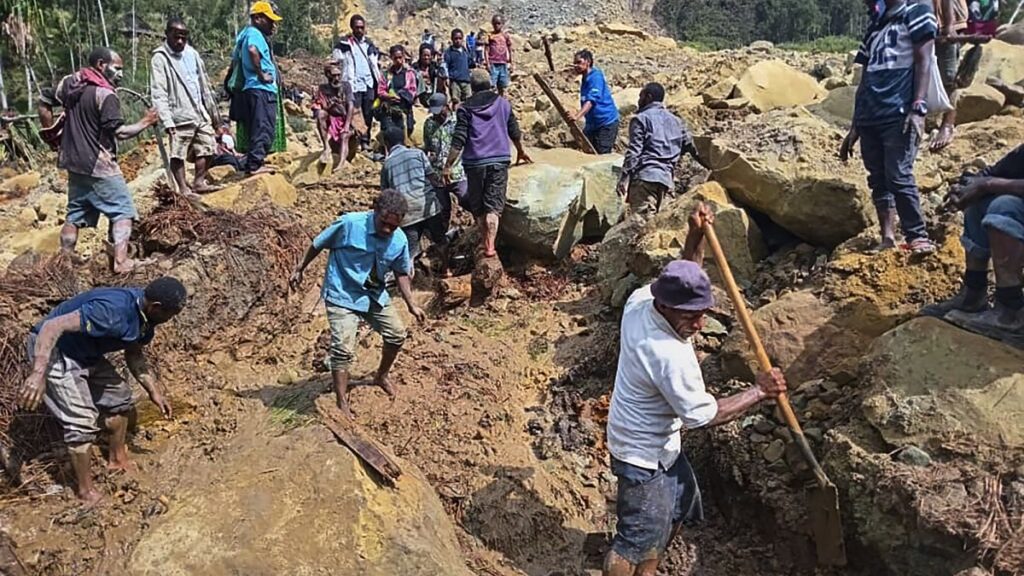Papua New Guinea informed the United Nations on Monday that more than 2,000 people were buried by a massive landslide that swept through a remote village, according to a copy of the letter obtained by the AP.
The Papua New Guinea government said a landslide on Friday buried more than 2,000 people and formally requested help from the international community.
The government figure is about three times higher than the United Nations estimatewhich is 670 people.
In a letter to the United Nations resident coordinator on Sunday and seen by The Associated Press, the acting director of the South Pacific island nation’s National Disaster Center said the landslide had “buried more than 2,000 people alive” and caused “major destruction”.
Estimates of the number of victims have varied widely since the disaster occurred, and it was not immediately clear how authorities calculated the number of people affected.
The International Organization for Migration (IOM) still estimated on Sunday that 670 the number of victims of the disaster which struck the village of Yambali, in the province of Enga, in the north of Papua New Guinea.
But already on Sunday Serhan Aktoprak, head of the IOM mission in the country, said that rescue teams have gave up hope of finding survivors underground at a depth of six to eight meters.
“People are waking up to the situation and there is a significant level of grief and mourning,” added Mr. Aktoprak.
Rescuers moved survivors to safer locations on Sunday as unstable ground threatened rescue operations.
The South Pacific island’s government is exploring the possibility of formally requesting additional international aid.
The government has established evacuation centers on either side of the debris, which covers an area equivalent to three or four football fields and cuts off the province’s main highway.
Since Saturday, convoys have been transporting food, water and other supplies to the devastated village.
Australia prepares to send aid
Australia prepared on Monday to send planes and other equipment to help at the site of a deadly landslide in Papua New Guinea, as overnight rains in the country’s mountainous interior South Pacific nation have raised fears that the tons of rubble that buried hundreds of villagers could become dangerously unstable.
Australian Defense Minister Richard Marles said his officials had been speaking with their Papua New Guinea counterparts since Friday, when a mountainside collapsed on the province’s Yambali village of Enga. The United Nations estimates that this collapse killed 670 people. The remains of only six people have been found so far.
“The exact nature of the support we provide will be defined in the coming days”Mr Marles told Australian Broadcasting Corp.
“Obviously we have airlift capacity to get people there. We may be able to bring in other equipment in terms of search and rescue, and we are discussing all of that with Papua New Guinea”, added Mr. Marles.
Papua New Guinea is Australia’s closest neighbor and the two countries are developing closer defense ties as part of Australia’s efforts to counter China’s growing influence in the region. Australia is also the most generous provider of foreign aid to its former colony, which became independent in 1975.
Heavy rain fell for two hours last night in the provincial capital of Wabag, 60 kilometers from the devastated village. No weather forecast was immediately available in Yambali, where communications are limited.
Papua New Guinea Defense Minister Billy Joseph and director of the government’s National Disaster Center Laso Mana flew on Sunday on an Australian military helicopter from the capital Port Moresby to Yambali, 600 kilometers to the northwest, to see for themselves what is needed.
Mr. Mana’s office posted a photo of him in Yambali, handing a local official a check for 500,000 kina ($130,000) to buy emergency supplies for the 4,000 displaced survivors.
The purpose of the visit was to decide whether the Papua New Guinea government should formally request more international aid.
Earthmoving equipment used by the Papua New Guinea army was transported to the disaster site, 400 kilometers from the east coast town of Lae.
Traumatized villagers are divided over whether to allow heavy equipment to dig up and possibly further damage the bodies of their buried loved ones, officials said.


